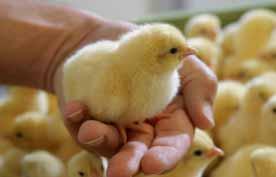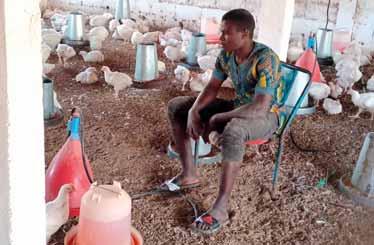
2 minute read
Anatomy
Day-old chicks
In general day-old chicks are bought by broiler farmers. The quality of the day-old chicks determines for a large part your final results. So make sure you have good starting material. Before you start, you have to know the breed you are buying and the vaccinations they received (and their mothers). The weight of day-old chicks doesn’t tell you much about the quality. If the Chick A Chick B copyright protected chicks have a large residual yolk in their body, they may weigh the same but are of lower quality. Chick length is a better indicator of the chick’s quality. This should be 18 centimetres or more, depending on parent stock age (young parent stock 18, older parents > 18).
Advertisement

Chick A, with a small residual yolk, has absorbed sufficient nutrients, is more vital, and would have had a stronger start (if it was still alive...). The smaller chick B has a large residual yolk. The chicks itself are also smaller. It has absorbed insufficient nutrients.
Quality of day-old chicks
On arrival, pick up chicks from various trays for a proper assessment so you can adapt your management to the quality of the chicks. The schedule below can help you with this. Weigh 5% of the chicks for a good idea of the initial weight of the day-old chicks and pay attention to uniformity. There are various abnormalities based on which chicks are rejected and separated from other chicks.
LOOK-THINK-ACT


A fit and healthy day-old chick gets on its feet again within three seconds, even when you put it on its back.
Yellow = better? Some people think that yellow chicks are more vital than white ones. But this is often due to formalin in the hatcher baskets, which colours the down. In the past, chicks that didn’t receive disinfection were considered less healthy, so colour was associated with health. Early hatched chicks are in contact with formalin for longer and will darker yellow, but might be weaker than the ones hatched later. copyright protected The legs should feel warmer when pressed against your cheek. The thermal image on the left shows warm legs. The legs in the image on the right are cold (they should appear lighter yellow than the hand).


Check points for day-old chicks
Check Right
Reflex Lay chick on its back. It should stand up within 3 seconds Chick takes more than 3 seconds to stand up: chick is listless
Eyes Clean, open and shiny Closed, dull Navel Navel should be closed and clean Bumpy: remnants of yolk; open navel; feathers smeared with albumen Feet Feet should be a normal colour and not swollen Feel warmer than your cheek Red hocks, swollen hocks, malformations, deformed toes, cold Beak Beak clean with closed nostrils Red spots; dirty nostrils; malformations Yolk sac Stomach soft and malleable Stomach hard and skin taut Down Should be dry and shiny Down wet and tacky Uniformity All chicks the same size More than 20% of chicks are 20% heavier or lighter than average Temperature Should be 40°C 2-3 hours after arrival Above 42°C: too high, below 38°C: too low






